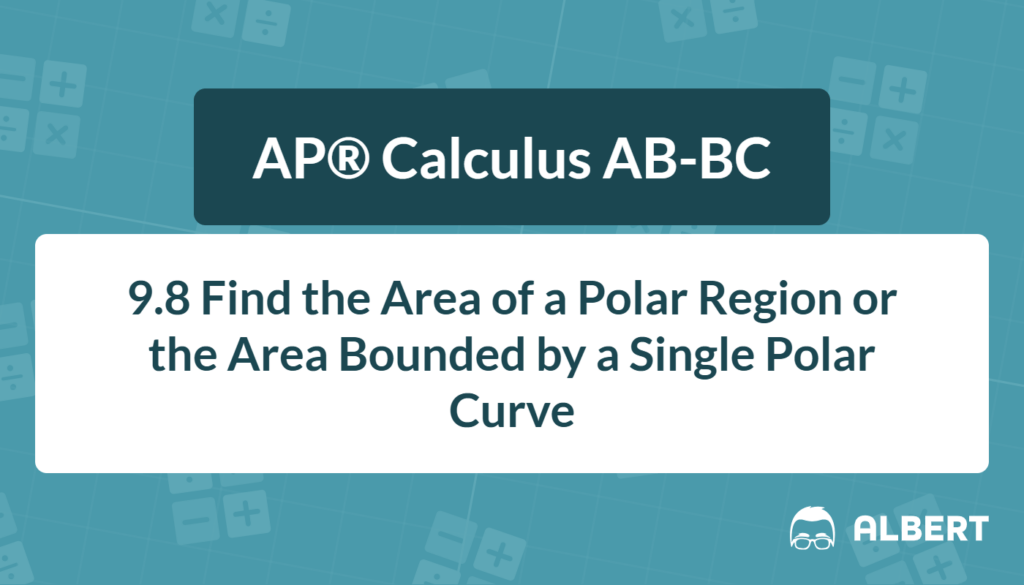From spiraling galaxies to blooming flowers, many beautiful patterns are easier to describe in polar coordinates than in ordinary x–y form. Therefore, AP® Calculus extends area techniques from rectangles to circular “pizza slices” by using the area of a polar curve and the polar area formula. This guide will
- refresh polar basics,
- build the formula step-by-step,
- show how to choose correct limits,
- work through two fully solved examples, and
- finish with a quick-reference chart and practice.
You’ll encounter phrases such as “area of a polar curve,” “area inside polar curve,” and “integrating in polar coordinates” throughout.
What We Review
Rectangular vs. Polar Coordinates (Fast Refresher)
- Rectangular coordinates locate a point with two distances: (x,y).
- Polar coordinates locate the same point with a distance and an angle: (r,θ)
Why switch?
- Curves like spirals, cardioids, and roses have short polar equations.
- Finding the area inside a polar curve often avoids messy splits such as x=f(y).
Graphing reminders
- Positive r moves outward along the terminal side of θ; negative r flips the point to the opposite side of the pole (origin).
- One polar equation can trace the same location many times. Therefore, always watch your limits of integration!
The Polar Area Formula (Core Concept)
Intuitive build-up
In rectangular form, a strip has area Δx⋅y. However, in polar form a skinny sector acts like a slice of pizza:
sector area≈21r2Δθ.Formal statement
For a continuous polar curve r=f(θ) traced once as θ runs from α to β,
A=21∫αβ[f(θ)]2dθ.Vocabulary spotlight
- Sector – pizza slice of a circle
- Radial slice – same as a sector, but very thin
- Integrand – the expression being integrated, here 21r2
- Bounds – starting and ending angles α,β
Area of a Polar Curve Example #1 – One Petal of a Rose
Find the area of one petal of r=2sin(3θ).
Step 1: Decide bounds
A graph or a quick check shows one petal is traced from θ=0 to θ=3π.

Step 2: Set up the integral
A=21∫0π/3(2sin3θ)2dθStep 3: Simplify before integrating
A=21∫0π/34sin23θdθ=2∫0π/3sin23θdθUse the identity sin2u=21(1−cos2u):
A=2∫0π/321(1−cos6θ)dθ=∫0π/3(1−cos6θ)dθStep 4: Integrate
A=[θ−61sin6θ]0π/3=3π−0=3πTherefore, one petal has area π/3 square units.
Choosing Limits of Integration (The Tricky Part)
Even after mastering the polar area formula, most errors come from improper limits. Use these ideas:
1. Look for where the curve meets the pole
Solve r=0. Those angles often mark the start or end of one complete trace.
2. For two curves, solve intersections
Set r1=r2. The solutions tell where the curves cross.
3. Always check a graph
Graphing tools such as Desmos (polar mode) or a graphing calculator can reveal accidental double-tracing within seconds.
Example #2 – Area Common to Two Curves
Find the area that lies inside both
r=3andr=2sinθ.Step 1: Understand the shapes
- r=3 is a circle of radius 3 centered at the pole.
- r=2sinθ is a circle of radius 1 centered at (0,1) in rectangular form.
The smaller circle sits completely inside the larger, so the overlap region is simply the inside of r=2sinθ.
Step 2: Bounds from the pole condition
Because 2sinθ≥0 only for 0≤θ≤π, those become our limits.
Step 3: Set up the integral
A=21∫0π(2sinθ)2dθStep 4: Compute
A=21∫0π4sin2θdθ=2∫0πsin2θdθBecause ∫0πsin2θdθ=2π,
A=2×2π=πSo the common region has area π square units.
Common Pitfalls & Pro Tips
- Double-tracing: If the curve loops twice over the same area, divide the angle interval accordingly.
- Negative r values: A negative radius really means “go the other way by π radians.” Therefore, re-express with a positive r when possible.
- Units: Because the integrand uses r2, final answers are always square units.
- Technology: A quick polar plot often prevents integration limits from being accidentally doubled or halved.
Quick Reference Chart
| Term | Meaning |
| Polar coordinates | Gives a point by distance r from the origin (pole) and angle θ from the positive x-axis |
| Pole | The origin in polar coordinates |
| Sector | A “pizza slice” of a circle, bounded by two radii and an arc |
| Polar area formula | A=21∫r2dθ |
| Bounds (α,β) | Starting and ending angles for integration |
| Petal | One loop of a rose curve such as r=asinnθ |
| Cardioid | Heart-shaped curve r=a(1±cosθ) or r=a(1±sinθ) |
Practice Problems
Try each question, then check the short answers below.
- Find the area inside the cardioid r=1+cosθ.
- Determine the area between the curves r=4cosθ (outer) and r=2 (inner) for −3π≤θ≤3π.
Answers (brief)
- Use A=21∫02π(1+cosθ)2dθ.
- Set up A=21∫−π/3π/3((4cosθ)2−22)dθ.
Conclusion
Calculating the area of a polar curve replaces rectangular strips with circular sectors and replaces width Δx with angle dθ. To master the skill, remember to
- express the curve as r=f(θ),
- pick correct limits,
- square the radius inside the integral, and
- multiply by 21.
Regular practice with graphs and varied examples cements the idea and prepares students for AP® Calculus questions on integrating in polar coordinates. Happy calculating!
Sharpen Your Skills for AP® Calculus AB-BC
Are you preparing for the AP® Calculus exam? We’ve got you covered! Try our review articles designed to help you confidently tackle real-world math problems. You’ll find everything you need to succeed, from quick tips to detailed strategies. Start exploring now!
- 9.7 Defining Polar Coordinates and Differentiating in Polar Form
- 9.9 Finding the Area of the Region Bounded by Two Polar Curves
Need help preparing for your AP® Calculus AB-BC exam?
Albert has hundreds of AP® Calculus AB-BC practice questions, free responses, and an AP® Calculus AB-BC practice test to try out.








